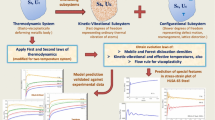Abstract
We consider the effect of the faults-defects (FD) field on the following quantum phenomena: (i) the motion of a particle expressed by the Green function; (ii) thermodynamic phenomena expressed by the partition function. We use the path integral formulation based on the extended deformation gradient (EDG) tensor. This formulation connects the Green function of (i) with the partition function of (ii) to describe the thermodynamics in terms of a quantum particle motion. We obtain the following results: (a) The Lagrangian in the Green function includes the new potential consisting of stress functions that shift the path of the free particle from the shortest distance; (b) The solution of the partition function in one-dimensional space makes it possible to deduce the thermodynamic relations in the FD field. Such results could not be obtained by taking the traditional mechanical and quantum approaches, so the path integral formulation based on the EDG tensor is a useful tool.
Similar content being viewed by others
References
Aharonov, Y., and D. Bohm (1959), Significance of electromagnetic potentials in the quantum theory, Phys. Rev. 115, 3, 485–491, DOI: 10.1103/PhysRev. 115.485.
Aki, K., and P.G. Richards (2002), Quantitative Seismology, 2nd ed., University Science Books, Sausalito, CA, 700 pp.
Bilby, B.A., R. Bullough, and E. Smith (1955), Continuous distributions of dislocations: A new application of the methods of non-Riemannian geometry, Proc. Roy. Soc. A 231, 1185, 263–273, DOI: 10.1098/rspa.1955.0171.
Das, A. (2006), Field Theory: A Path Integral Approach (Lecture Notes in Physics, Vol. 75), 2nd ed., World Scientific, Singapore, 362 pp.
Feynman, R.P., and A.R. Hibbs (1965), Quantum Mechanics and Path Integrals, McGraw-Hill, New York.
Hu, S. (2001), Lecture Notes on Chern-Simons-Witten theory, World Scientific, Singapore.
Kawamura, K. (1978), Scattering of electrons due to screw dislocations, Z. Physik B 30, 1, 1–11, DOI: 10.1007/BF01323663.
Kitahara, K., K. Nakazato, and H. Araki (1983), Path integral foundation of quantum propagation in a dislocated lattice. In: T. Ninomiya and F. Yonezawa (eds.), Topological Disorder in Condensed Matter, Springer, New York, 153–162.
Kleinert, H. (2004), Path Integrals in Quantum Mechanics, Statistics Polymer Physics, and Financial Markets, 3rd ed., World Scientific, Singapore.
Kondo, K. (1952), On the geometrical and physical foundation of the theory of yielding, Proc. 2nd Japan National Congr. on Applied Mechanics (Tokyo) 2, 41–47.
Kossecka, E., and R. DeWitt (1977), Disclination kinematics, Arch. Mech. 29, 633–651.
Majewski, E. (2001), Thermodynamics of fault slip. In: R. Teisseyre and E. Majewski (eds.), Earthquake Thermodynamics and Phase Transformations in the Earth’s Interior, Academic Press, San Diego, 323–327.
Majewski, E., and R. Teisseyre (1997), Earthquake thermodynamics, Tectonophysics 227, 1–3, 219–233, DOI: 10.1016/S0040-1951(97)00088-7.
Nishiyama, Y., K.Z. Nanjo, and K. Yamasaki (2008), Geometrical minimum units of fracture patterns in two-dimensional space: Lattice and discrete Walsh functions, Physica A 387, 25, 6252–6262, DOI: 10.1016/j.physa.2008.07.014.
Steketee, J.A. (1958), On Volterra’s dislocations in a semi-infinite elastic medium, Can. J. Phys. 36, 192–205.
Swanson, M.S. (1992), Path Integrals and Quantum Processes, Academic Press, Boston.
Takeo, M., and H. Ito (1997), What can be learned from rotational motions excited by earthquakes?, Geophys. J. Int. 129, 2, 319–329, DOI: 10.1111/j.1365-246X.1997.tb01585.x.
Teisseyre, R. (1995), Differential geometry methods in deformation problems. In: R. Teisseyre (ed.), Theory of Earthquake Premonitory and Fracture Processes, Polish Scientific Publisher, Warszawa, 503–544.
Teisseyre, R., and E. Majewski (2001), Thermodynamics of line defects and earthquake thermodynamics. In: R. Teisseyre and E. Majewski (eds.), Earthquake Thermodynamics and Phase Transformations in the Earth’s Interior, Academic Press, San Diego, 261–278.
Teisseyre, R., M. Takeo, and E. Majewski (eds.) (2006), Earthquake Source Asymmetry, Structural Media and Rotation Effects, Springer, Berlin.
Yamasaki, K. (2005), Tensor analysis of dislocation-stress relationship based on the extended deformation gradient, Acta Geophys. Pol. 53, 1–12.
Yamasaki, K. (2007), Betti numbers of defects field, Forma 22, 191–197.
Yamasaki, K., and H. Nagahama (1999), Hodge duality and continuum theory of defects, J. Phys. A: Math. Gen. 32, 44, L475–L481, DOI: 10.1088/0305-4470/32/44/103.
Yamasaki, K., and H. Nagahama (2002), A deformed medium including a defect field and differential forms, J. Phys. A: Math. Gen. 35, 16, 3767–3778, DOI: 10.1088/0305-4470/35/16/315.
Yamasaki, K., and H. Nagahama, (2008), Energy integral in fracture mechanics (J-integral) and Gauss-Bonnet theorem, ZAMM: J. Appl. Math. Mech. 88, 6, 515–520, DOI: 10.1002/zamm.200700140.
Yamasaki, K., and K.Z. Nanjo (2009), A new mathematical tool for analyzing the fracturing process in rock: Partial symmetropy of microfracturing, Phys. Earth Planet. Inter. 173, 3–4, 297–305, DOI: 10.1016/j.pepi.2009.01.010.
Witten, E. (1989) Quantum field theory and the Jones polynomial, Commun. Math. Phys. 121, 3, 351–399, DOI: 10.1007/BF01217730.
Wiegel, F.W. (1975), Path integral methods in statistical mechanics, Phys. Rep. 16, 2, 57–114, DOI: 10.1016/0370-1573(75)90030-7.
Author information
Authors and Affiliations
Corresponding author
Rights and permissions
About this article
Cite this article
Yamasaki, K. A quantum particle motion and thermodynamics in faults-defects field: Path integral formulation based on extended deformation gradient tensor. Acta Geophys. 57, 567–582 (2009). https://doi.org/10.2478/s11600-009-0016-7
Received:
Accepted:
Published:
Issue Date:
DOI: https://doi.org/10.2478/s11600-009-0016-7




